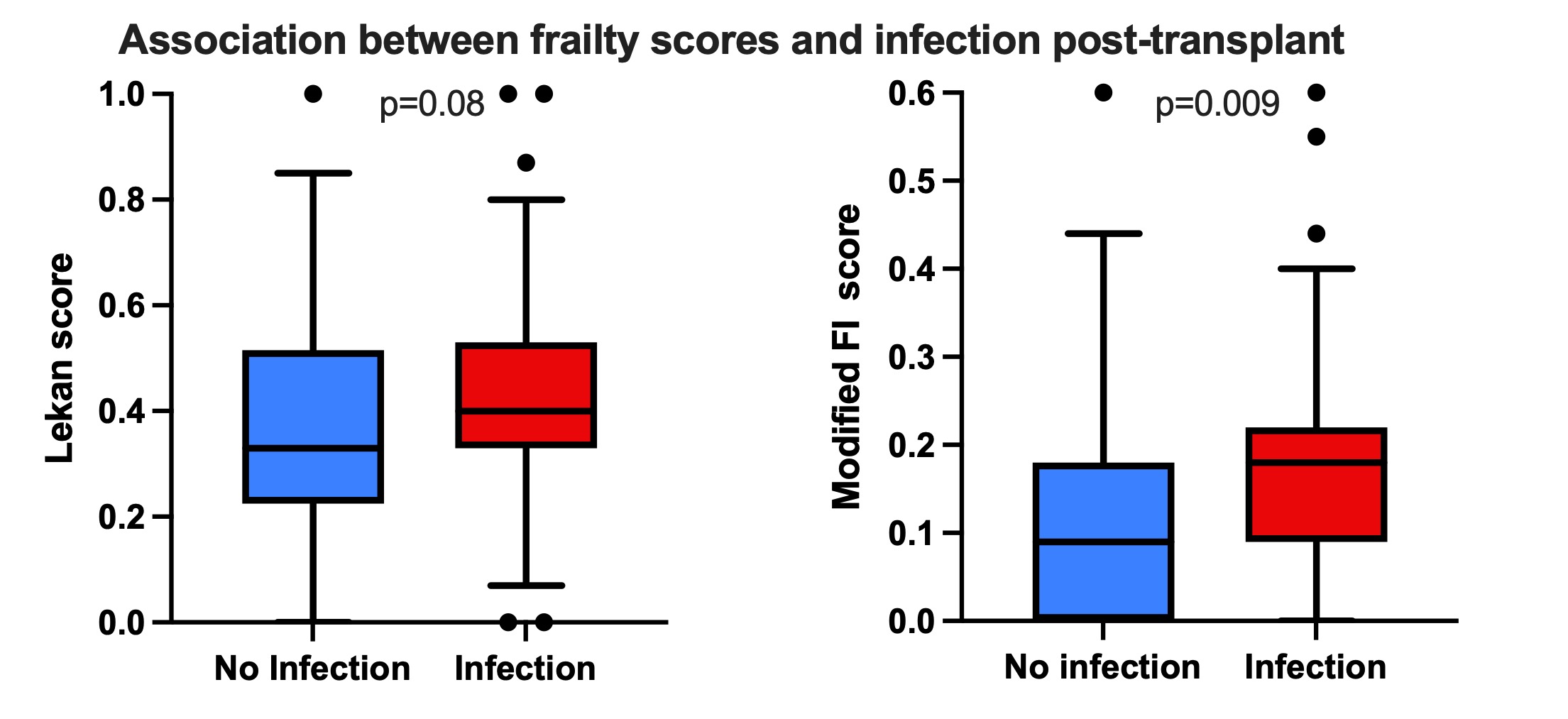Pre-Transplant Frailty Predicts Infection After Liver Transplant in a Multi-Center Study of Older Adults
M. Malinis1, M. Abidi2, E. Benamu2, N. Jakharia3, N. Law4, R. Sigler4, R. Nog5, S. Olivier5, S. Taimur6, N. Theodoropoulos7, J. Schaenman8
1Yale SOM, New Haven, CT, 2Univ of CO, Aurora, CO, 3Stanford, Palo, Alto, CA, 4UCSD, San Diego, CA, 5Westchester Med Ctr, Westchester, NY, 6Mount Sinai SOM, New York, NY, 7Univ of MA, Worcester, MA, 8UCLA, Los Angeles, CA
Meeting: 2022 American Transplant Congress
Abstract number: 351
Keywords: Infection, Liver transplantation, Outcome
Topic: Clinical Science » Infection Disease » 24 - All Infections (Excluding Kidney & Viral Hepatitis)
Session Information
Session Name: Transplant Infectious Diseases: All Organs
Session Type: Rapid Fire Oral Abstract
Date: Monday, June 6, 2022
Session Time: 5:30pm-7:00pm
 Presentation Time: 5:30pm-5:40pm
Presentation Time: 5:30pm-5:40pm
Location: Hynes Ballroom B
*Purpose: Frailty is a complex multi-system characterization of reduced physiologic reserve and functional decline in older adults. At the time of transplant, frailty has been associated with mortality in liver transplant recipients (LTR). The association of frailty with infection after liver transplant (LT) remains to be determined. Our study represents the largest cohort evaluating frailty as a predictor of infection after LT in older adults.
*Methods: A multi-center, retrospective, observational study of primary LTR age ≥50 years between 2017-2019 was conducted through the AST IDCOP Older Adult working group. Demographics, co-morbidities, transplant-related data, and infections within 1-year of LT were collected. Frailty was defined by modified frailty index (MFI) ≥0.27 and Lekan frailty index (LFI) >0.3. The primary outcome measured was infection within 1 year of LT. A multivariate analysis was performed to evaluate factors associated with post-LT infection.
*Results: 182 LTR were evaluated. The mean age was 60.6 (SD 5.8) years with a mean calculated MELD of 30 (SD 9.7) at time of LT. Majority were male (63%) and white (61%). Hepatocellular carcinoma (43%), HCV (40%), alcohol-related cirrhosis (31%) were common LT indications. The MFI and LFI scores were 0.14 (SD 0.12) and 0.41 (SD 0.20), respectively. The mean follow-up time was 1256 days, with patient and graft survival of 89% and 86%, respectively. One hundred fifteen LTRs (63%) experienced ≥ 1 infection during the first year of LT with a mean time of 62.4 days (SD 88.4) from LT. Intra-abdominal (30%), pulmonary (14%), and genitourinary (12%) infections were common. The median MFI of LTR with infection was 0.2 compared to those without infection was 0.3 (p=0.08). Multivariate analysis, including frailty assessment and age, demonstrated the association between categorical MFI score and post-transplant infection (p=0.004), while age was not statistically significant (p=0.274). Similarly, findings were observed for multivariable analysis with the LFI (p=0.002), demonstrating that the predictive value of frailty is independent of LTR age.
*Conclusions: Frailty, independent of age, was associated with increased risk for 1-year post-LT infection. Assessing for frailty and incorporating strategies to improve frail status prior to LT may reduce the risk for post-transplant infection.
To cite this abstract in AMA style:
Malinis M, Abidi M, Benamu E, Jakharia N, Law N, Sigler R, Nog R, Olivier S, Taimur S, Theodoropoulos N, Schaenman J. Pre-Transplant Frailty Predicts Infection After Liver Transplant in a Multi-Center Study of Older Adults [abstract]. Am J Transplant. 2022; 22 (suppl 3). https://atcmeetingabstracts.com/abstract/pre-transplant-frailty-predicts-infection-after-liver-transplant-in-a-multi-center-study-of-older-adults/. Accessed January 4, 2026.« Back to 2022 American Transplant Congress

